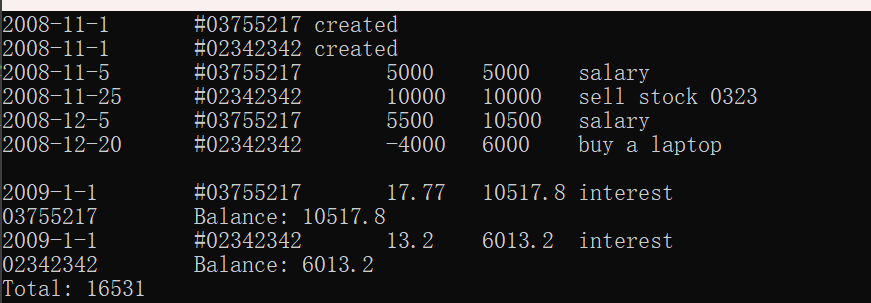实验3
实验一
botton.hpp
#pragma once #include<iostream> #include<string> using std::string; using std::cout; class Button{ public: Button(const string &text); string get_label() const; void click(); private: string label; }; Button::Button(const string &text):label{text}{} inline string Button::get_label() const {return label;} void Button::click (){ cout<<"Button'"<<label<<"'clicked\n"; }
window.hpp
#pragma once #include"botton.hpp" #include<vector> #include<iostream> using std::vector; using std::cout; using std::endl; //窗口类 class Window{ public: Window(const string &win_title); void display() const; void close(); void add_button(const string &label); private: string title; vector<Button> buttons; }; Window::Window(const string &win_title):title{win_title}{ buttons.push_back(Button("close")); } inline void Window::display() const{ string s(40,'*'); cout<< s <<endl; cout<<"Window title:"<<title<<endl; cout<<"It has"<<buttons.size()<<"buttons:"<<endl; for(const auto &i:buttons) cout<<i.get_label()<<"button"<<endl; cout<<s<<endl; } void Window::close() { cout<<"close window'"<<title<<"'"<<endl; buttons.at(0).click(); } void Window::add_button(const string &label){ buttons.push_back(Button(label)); }
task1.cpp
#include"window.hpp" #include<iostream> using std::cout; using std::cin; void test(){ Window w1("new window"); w1.add_button("maximize"); w1.display(); w1.close() ; } int main(){ cout<<"用组合类模拟简单GUI:\n"; test(); }
实验结果:
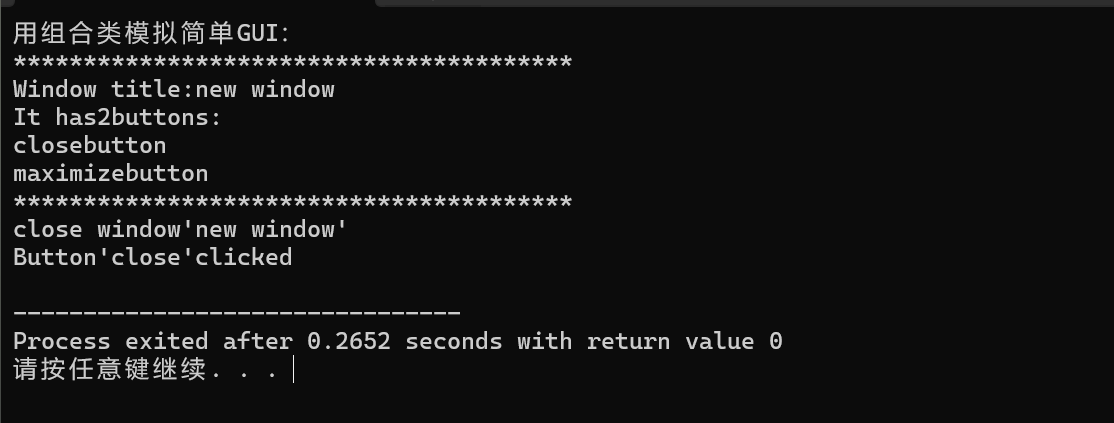
问题1:这个模拟简单GUI的示例代码中,自定义了几个类?使用到了标准库的哪几个类?,
哪些类和类之间存在组合关系?
自定义了两个类,使用了标准库中的<string>和<vector>类。botton类和string类之间存在组合关系,
botton,window和vector之间也存在组合关系。
问题2:在自定义类Button和Window中,有些成员函数定义时加了const, 有些设置成了
inline。如果你是类的设计者,目前那些没有加const或没有设置成inline的,适合添加const,
适合设置成inline吗?你的思考依据是?
Window::add_button()和Button::click()不应该设置为inline,因为它们修改了外部状态或涉及到较为复杂的操作。
Window::close()不应该添加const,因为它调用了可能会修改外部状态的函数。
问题3:类Window的定义中,有这样一行代码,其功能是?
创建一个string类型的变量s,初始化为40个星号。
实验二:
#include <iostream> #include <stdlib.h> #include <vector> using namespace std; void output1(const vector<int> &v) { for (auto &i : v) cout << i << ", "; cout << "\b\b \n"; } void output2(const vector<vector<int>> v) { for (auto &i : v) { for (auto &j : i) cout << j << ", "; cout << "\b\b \n"; } } void test1() { vector<int> v1(5, 42); const vector<int> v2(v1); v1.at(0) = -999; cout << "v1: "; output1(v1); cout << "v2: "; output1(v2); cout << "v1.at(0) = " << v1.at(0) << endl; cout << "v2.at(0) = " << v2.at(0) << endl; } void test2() { vector<vector<int>> v1{{1, 2, 3}, {4, 5, 6, 7}}; const vector<vector<int>> v2(v1); v1.at(0).push_back(-999); cout << "v1: \n"; output2(v1); cout << "v2: \n"; output2(v2); vector<int> t1 = v1.at(0); cout << t1.at(t1.size() - 1) << endl; const vector<int> t2 = v2.at(0); cout << t2.at(t2.size() - 1) << endl; } int main() { cout << "测试1:\n"; test1(); cout << "\n测试2:\n"; test2(); system("pause"); }
实验结果:

问题1:测试1模块中,这三行代码的功能分别是?
第一行:创建一个int类型的5个元素每个元素为42的动态数组。
第二行:创建一个v2将v1复制过去。
第三行:将v1的0号单元改为-999。
问题2:测试2模块中,这三行代码的功能分别是?
第一行:创建了一个二维的vector,包含两个元素,依次是vector类型的1,2,3和vector类型的4,5,6,7。
第二行:创建了另一个名为v2的二维vector,并且是const,一旦初始化后v2的内容不能被修改。v2被初始化为v1的副本。
第三行:在v1的末尾增加一个新的元素-999。
问题3:测试2模块中,这四行代码的功能分别是?
第一行:这行代码创建了一个名为t1的一维std::vector<int>,并将其初始化为v1的第一个内部vector。
第二行:将t1的最后一个元素输出。
第三行:这行代码创建了一个名为t2的一维std::vector<int>,并将其初始化为v2的第一个内部vector。
第四行:将t2的最后一个元素输出。
问题4:根据执行结果,反向分析、推断:
① 标准库模板类vector内部封装的复制构造函数,其实现机制是深复制还是浅复制?
是深复制。
② 模板类vector的接口at(), 是否至少需要提供一个const成员函数作为接口?
是的,vector的at()成员函数至少需要提供一个const版本。
实验三:
vectorInt.hpp
#pragma once #include <cassert> #include <iostream> using std::cout; using std::endl; // 动态int数组对象类 class vectorInt { public: vectorInt(int n); vectorInt(int n, int value); vectorInt(const vectorInt &vi); ~vectorInt(); int &at(int index); const int &at(int index) const; vectorInt &assign(const vectorInt &v); int get_size() const; private: int size; int *ptr; // ptr指向包含size个int的数组 }; vectorInt::vectorInt(int n) : size{n}, ptr{new int[size]} { } vectorInt::vectorInt(int n, int value) : size{n}, ptr{new int[size]} { for (auto i = 0; i < size; ++i) ptr[i] = value; } vectorInt::vectorInt(const vectorInt &vi) : size{vi.size}, ptr{new int[size]} { for (auto i = 0; i < size; ++i) ptr[i] = vi.ptr[i]; } vectorInt::~vectorInt() { delete[] ptr; } const int &vectorInt::at(int index) const { assert(index >= 0 && index < size); return ptr[index]; } int &vectorInt::at(int index) { assert(index >= 0 && index < size); return ptr[index]; } vectorInt &vectorInt::assign(const vectorInt &v) { delete[] ptr; // 释放对象中ptr原来指向的资源 size = v.size; ptr = new int[size]; for (int i = 0; i < size; ++i) ptr[i] = v.ptr[i]; return *this; } int vectorInt::get_size() const { return size; }
task3.cpp
#include "vectorInt.hpp" #include <iostream> using std::cin; using std::cout; void output(const vectorInt &vi) { for (auto i = 0; i < vi.get_size(); ++i) cout << vi.at(i) << ", "; cout << "\b\b \n"; } void test1() { int n; cout << "Enter n: "; cin >> n; vectorInt x1(n); for (auto i = 0; i < n; ++i) x1.at(i) = i * i; cout << "x1: "; output(x1); vectorInt x2(n, 42); vectorInt x3(x2); x2.at(0) = -999; cout << "x2: "; output(x2); cout << "x3: "; output(x3); } void test2() { const vectorInt x(5, 42); vectorInt y(10, 0); cout << "y: "; output(y); y.assign(x); cout << "y: "; output(y); cout << "x.at(0) = " << x.at(0) << endl; cout << "y.at(0) = " << y.at(0) << endl; } int main() { cout << "测试1: \n"; test1(); cout << "\n测试2: \n"; test2(); }
实验结果:
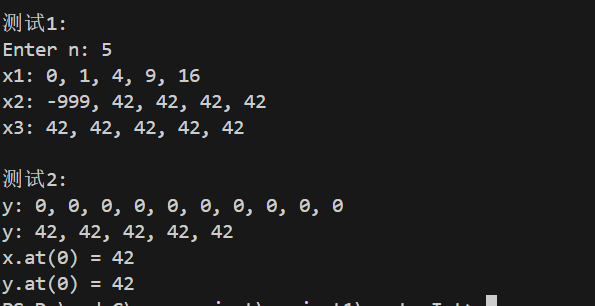
实验四:
matrix.hpp
#pragma once #include <cassert> #include <iostream> using std::cout; using std::endl; // 类Matrix的声明 class Matrix { public: Matrix(int n, int m); // 构造函数,构造一个n*m的矩阵, 初始值为value Matrix(int n); // 构造函数,构造一个n*n的矩阵, 初始值为value Matrix(const Matrix &x); // 复制构造函数, 使用已有的矩阵X构造 ~Matrix(); void set(const double *pvalue); // 用pvalue指向的连续内存块数据按行为矩阵赋值 void clear(); // 把矩阵对象的值置0 const double &at(int i, int j) const; // 返回矩阵对象索引(i,j)的元素const引用 double &at(int i, int j); // 返回矩阵对象索引(i,j)的元素引用 int get_lines() const; // 返回矩阵对象行数 int get_cols() const; // 返回矩阵对象列数 void display() const; // 按行显示矩阵对象元素值 private: int lines; // 矩阵对象内元素行数 int cols; // 矩阵对象内元素列数 double *ptr; }; Matrix::Matrix(int n, int m) : lines{n}, cols{m}, ptr{new double[n * m]} { clear(); } Matrix::Matrix(int n) : lines{n}, cols{n}, ptr{new double[n * n]} { clear(); } Matrix::Matrix(const Matrix &x) : lines{x.lines}, cols{x.cols}, ptr{new double[x.lines * x.cols]} { for (int i = 0; i < x.lines * x.cols; i++) { *(ptr + i) = *(x.ptr + i); } } Matrix::~Matrix() { delete[] ptr; } void Matrix::set(const double *pvalue) { for (int i = 0; i < lines * cols; i++) ptr[i] = pvalue[i]; } void Matrix::clear() { for (int i = 0; i < lines * cols; i++) { ptr[i] = 0; } } const double &Matrix::at(int i, int j) const { return ptr[i * cols + j]; } double &Matrix::at(int i, int j) { return ptr[i * cols + j]; } int Matrix::get_cols() const { return cols; } int Matrix::get_lines() const { return lines; } void Matrix::display() const { for (int i = 0; i < lines; i++) { for (int j = 0; j < cols; j++) { cout << ptr[i * cols + j]; cout << " "; } cout << endl; } }
task4.cpp
#include "matrix.hpp" #include <cassert> #include <iostream> using std::cin; using std::cout; using std::endl; const int N = 1000; // 输出矩阵对象索引为index所在行的所有元素 void output(const Matrix &m, int index) { assert(index >= 0 && index < m.get_lines()); for (auto j = 0; j < m.get_cols(); ++j) cout << m.at(index, j) << ", "; cout << "\b\b \n"; } void test1() { double x[1000] = {1, 2, 3, 4, 5, 6, 7, 8, 9}; int n, m; cout << "Enter n and m: "; cin >> n >> m; Matrix m1(n, m); // 创建矩阵对象m1, 大小n×m m1.set(x); // 用一维数组x的值按行为矩阵m1赋值 Matrix m2(m, n); // 创建矩阵对象m1, 大小m×n m2.set(x); // 用一维数组x的值按行为矩阵m1赋值 Matrix m3(2); // 创建一个2×2矩阵对象 m3.set(x); // 用一维数组x的值按行为矩阵m4赋值 cout << "矩阵对象m1: \n"; m1.display(); cout << endl; cout << "矩阵对象m2: \n"; m2.display(); cout << endl; cout << "矩阵对象m3: \n"; m3.display(); cout << endl; } void test2() { Matrix m1(2, 3); m1.clear(); const Matrix m2(m1); m1.at(0, 0) = -999; cout << "m1.at(0, 0) = " << m1.at(0, 0) << endl; cout << "m2.at(0, 0) = " << m2.at(0, 0) << endl; cout << "矩阵对象m1第0行: "; output(m1, 0); cout << "矩阵对象m2第0行: "; output(m2, 0); } int main() { cout << "测试1: \n"; test1(); cout << "测试2: \n"; test2(); }
实验结果:
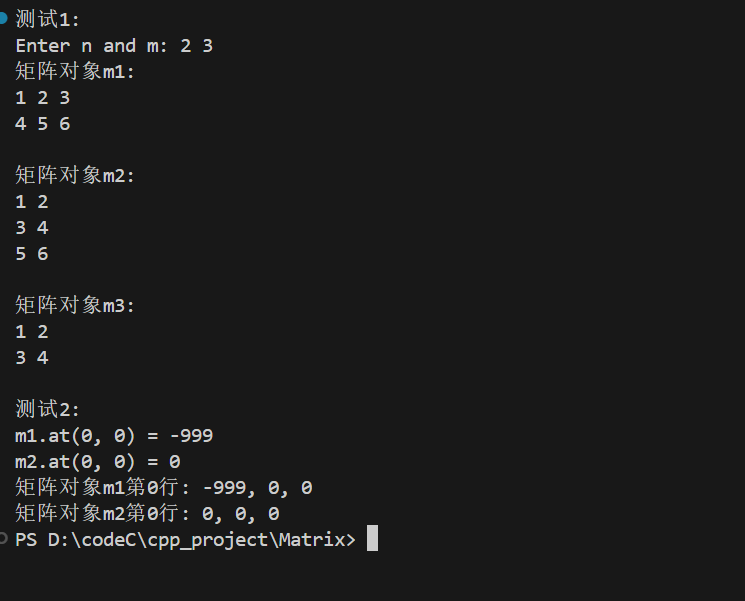
实验五:
user.hpp
#pragma once #include <iostream> #include <string> using namespace std; class User { public: User(string name, string password = "123456", string email = ""); void set_email(); void change_password(); void display() const; private: string name; string password; string email; }; User::User(string name, string password, string email) : name{name}, password{password}, email{email} {} void User::set_email() { string input; do { cout << "请输入邮箱: "; getline(cin, input); // 简单的邮箱合法性校验 if (input.find('@') != string::npos) { email = input; } else { cout << "非法邮箱,请输入包含@的邮箱。" << endl; } } while (input.find('@') == string::npos); } void User::change_password() { string old_password; int attempts = 0; while (attempts < 3) { cout << "请输入旧密码: "; cin >> old_password; if (old_password == password) { string new_password; cout << "请输入新密码: "; cin >> new_password; password = new_password; return; } else { cout << "密码错误。" << endl; attempts++; if (attempts == 3) { cout << "连续三次输入错误,稍后再试。" << endl; } } } } void User::display() const { cout << "用户名: " << name << endl; cout << "密码: " << string(password.length(), '*') << endl; cout << "邮箱: " << email << endl; }
task5.cpp
#include "user.hpp" #include <iostream> #include <string> #include <vector> using std::cin; using std::cout; using std::endl; using std::string; using std::vector; void test() { vector<User> user_lst; User u1("Alice", "2024113", "Alice@hotmail.com"); user_lst.push_back(u1); cout << endl; User u2("Bob"); u2.set_email(); u2.change_password(); user_lst.push_back(u2); cout << endl; User u3("Hellen"); u3.set_email(); u3.change_password(); user_lst.push_back(u3); cout << endl; cout << "There are " << user_lst.size() << " users. they are: " << endl; for (auto &i : user_lst) { i.display(); cout << endl; } } int main() { test(); }
实验结果:
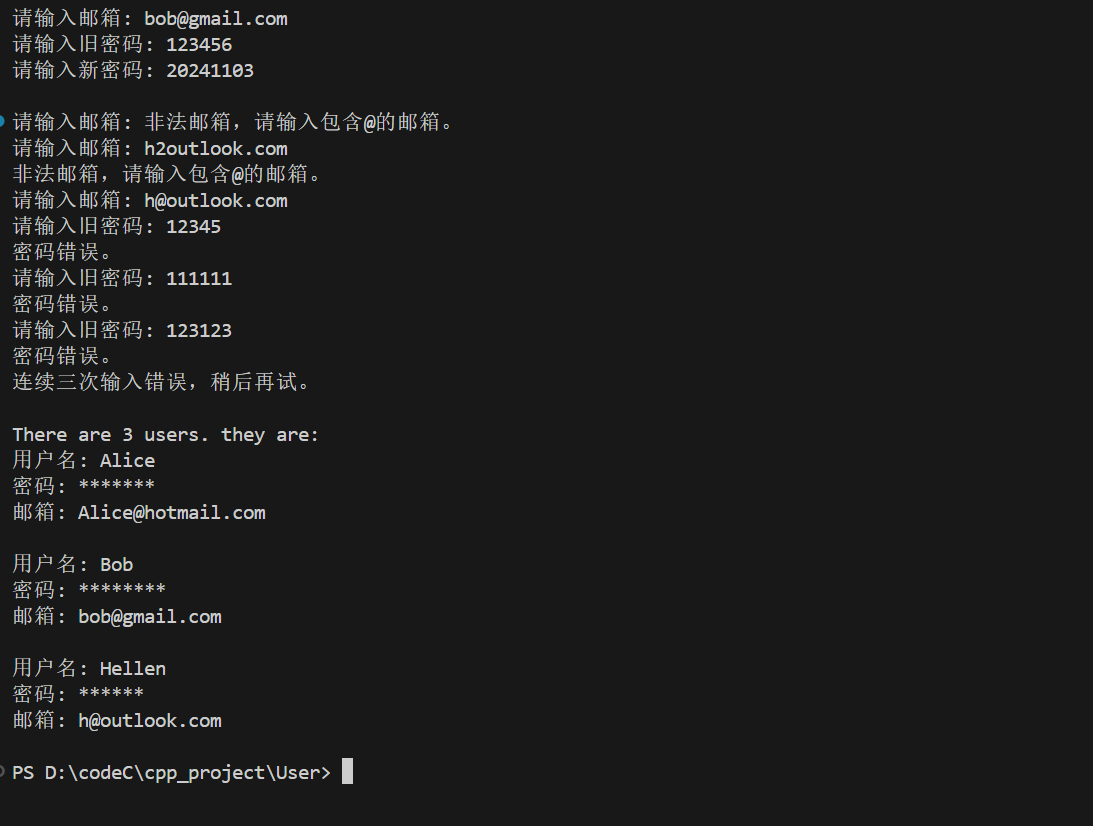
实验任务六:
date.h
#ifndef __DATE_H__ #define __DATE_H__ class Date { private: int year; //年 int month; //月 int day; //日 int totalDays; //该日期是从公元元年1月1日开始的第几天 public: Date(int year, int month, int day); //用年、月、日构造日期 int getYear() const { return year; } int getMonth() const { return month; } int getDay() const { return day; } int getMaxDay() const; bool isLeapYear() const { return year % 4 == 0 && year % 100 != 0 || year % 400 == 0; } void show() const; //计算两个日期之间相差多少天 int distance(const Date& date) const { return totalDays - date.totalDays; } }; #endif
date.cpp
#include "date.h" #include <iostream> #include <cstdlib> using namespace std; //命名空间使下面的定义只在当前文件中有效 namespace { //存储平年中的某个月1日之前有多少天,为便于getMaxDay函数的实现,该数组多出一项 const int DAYS_BEFORE_MONTH[] = { 0, 31, 59, 90, 120, 151, 181, 212, 243, 273, 304, 334, 365 }; } Date::Date(int year, int month, int day) : year(year), month(month), day(day) { if (day <= 0 || day > getMaxDay()) { cout << "Invalid date."; show(); cout << endl; exit(1); } int years = year - 1; totalDays = years * 365 + years / 4 - years / 100 + years / 400 + DAYS_BEFORE_MONTH[month-1] + day; if (isLeapYear() && month > 2) totalDays++; } int Date::getMaxDay()const { if (isLeapYear() && month == 2) { return 29; } else { return DAYS_BEFORE_MONTH[month] - DAYS_BEFORE_MONTH[month - 1]; } } void Date::show() const { cout << getYear() << '-' << getMonth() << '-' << getDay(); }
account.h
#ifndef __ACCOUNT_H__ #define __ACCOUNT_H__ #include "date.h" #include <string> class SavingsAccount { private: std::string id; //账号 double balance; //余额 double rate; //存款的年利率 Date lastDate; //上次变更余额的日期 double accumulation; //余额按日累加之和 static double total; //所有账户的总金额 //记录一笔帐,date为日期,amount为金额,desc为说明 void record(const Date& date, double amount, const std::string& desc); //报告错误信息 void error(const std::string& msg) const; //获得指定日期为止的存款金额按日累积值 double accumulate(const Date& date) const { return accumulation + balance * date.distance(lastDate); } public: //构造函数 SavingsAccount(const Date& date, const std::string& id, double rate); const std::string& getId() const { return id; } double getBalance() const { return balance; } double getRate() const { return rate; } static double getTotal() { return total; } //存入现金 void deposit(const Date& date, double amount, const std::string& desc); //取出现金 void withdraw(const Date& date, double amount, const std::string& desc); //结算利息,每年1月1日调用一次该函数 void settle(const Date& date); //显示账户信息 void show() const; }; #endif // ACCOUNT_H
account.cpp
#include "account.h" #include <cmath> #include <iostream> using namespace std; double SavingsAccount::total = 0; SavingsAccount::SavingsAccount(const Date& date, const std::string& id, double rate):id(id), balance(0), rate(rate), lastDate(date), accumulation(0){ date.show(); cout<< "\t#" << id << " created" << endl; } void SavingsAccount::record(const Date& date, double amount, const std::string& desc) { accumulation = accumulate(date); lastDate = date; amount = floor(amount * 100 + 0.5) / 100; //保留小数点后两位 balance += amount; total += amount; date.show(); cout << "\t#" << id << "\t" << amount << "\t" << balance << "\t" << desc << endl; } void SavingsAccount::error(const std::string& msg) const { cout << "Error(#" << id << "): " << msg << endl; } void SavingsAccount::deposit(const Date& date, double amount, const std::string& desc) { record(date, amount, desc); } void SavingsAccount::withdraw(const Date& date, double amount, const std::string& desc) { if (amount > getBalance()) error("not enough money"); else record(date, -amount, desc); } void SavingsAccount::settle(const Date& date) { double interest = accumulate(date) * rate /date.distance(Date(date.getYear()-1,1,1)); if (interest != 0) record(date, interest, "interest"); accumulation = 0; } void SavingsAccount::show() const { cout << id << "\tBalance: " << balance; }
6_25.cpp
#include "account.h" #include <iostream> using namespace std; int main() { Date date(2008, 11, 1); //起始日期 //建立账户 SavingsAccount accounts[] = { SavingsAccount(date, "03755217", 0.015), SavingsAccount(date, "02342342", 0.015) }; const int n = sizeof(accounts) / sizeof(SavingsAccount); //账户总数 //11月份的几笔账目 accounts[0].deposit(Date(2008, 11, 5), 5000, "salary"); accounts[1].deposit(Date(2008, 11, 25), 10000, "sell stock 0323"); //12月份的几笔账目 accounts[0].deposit(Date(2008, 12, 5), 5500, "salary"); accounts[1].withdraw(Date(2008, 12, 20), 4000, "buy a laptop"); //结算所有账户并输出各个账户信息 cout << endl; for (int i = 0; i < n; i++) { accounts[i].settle(Date(2009, 1, 1)); accounts[i].show(); cout << endl; } cout << "Total: " << SavingsAccount::getTotal() << endl; return 0; }
实验结果:
